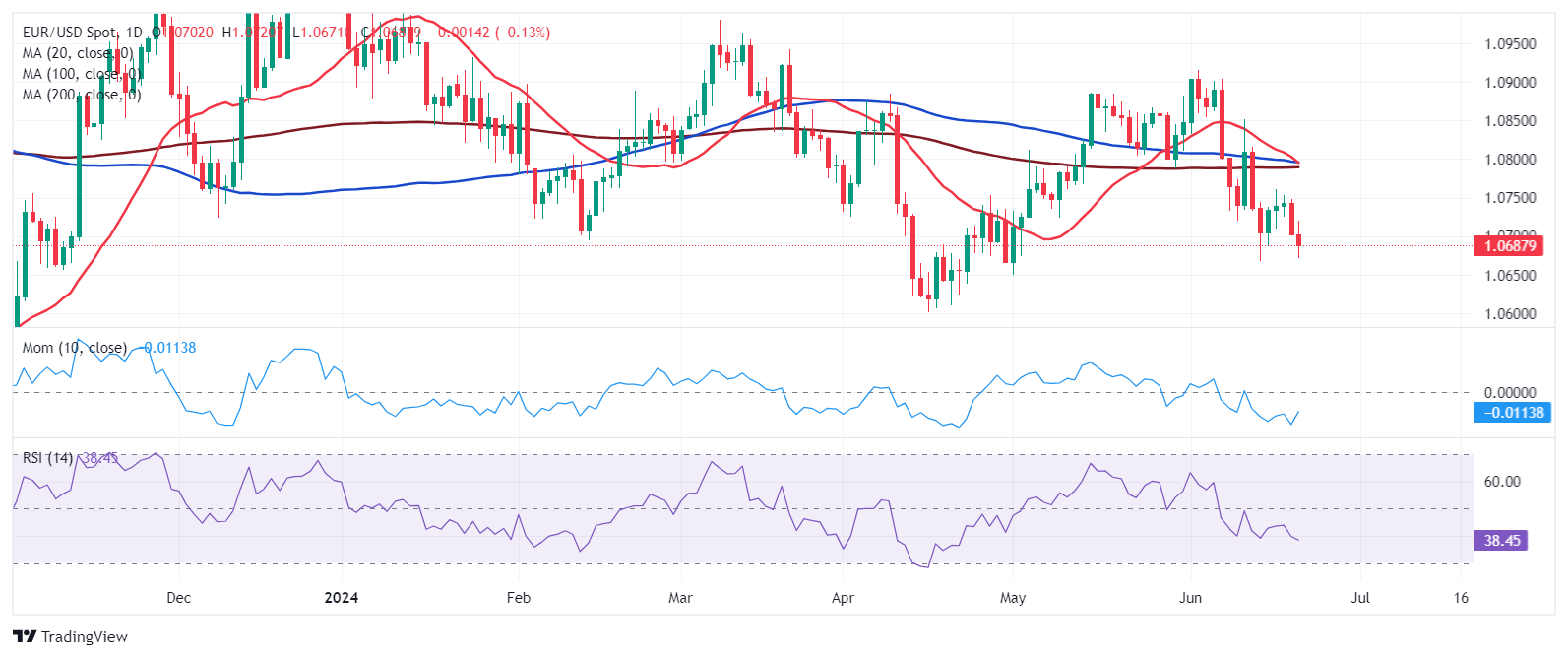- Encouraging US data ahead of the weekly close boosted demand for the US Dollar.
- The United States will release the Federal Reserve’s favorite inflation gauge next week.
- EUR/USD trades near its lowest level in June, bears aim to challenge the year-to-date low.
The US Dollar (USD) retained the ground gained in the previous days, and EUR/USD settled below the 1.0700 threshold for a second consecutive week. The pair moved mostly on sentiment, although tepid United States (US) data pushed EUR/USD up to 1.0760 on Tuesday. Nevertheless, the Greenback regained its strength ahead of the close, as geopolitical jitters backed safe-haven demand.
Beyond European woes after far-right parties dominated the European Parliament Election, the focus was on Russia. President Vladimir Putin said on Thursday that the country is considering introducing changes to its nuclear doctrine, including lowering the threshold for the use of such weapons in the West. Additionally, Putin said that Russia could provide other countries with its weapons as the West does to Ukraine.
United States data disappoints
US Retail Sales posted a modest 0.1% advance in May, while April's figure was downwardly revised to -0.2%. Furthermore, Initial Jobless Claims for the week ended June 14 were up by 238K, worse than the 235K expected. At the same time, Building Permits fell by 3.8% mont-over-month (MoM) in May, while Housing Starts declined by 5.5%. Finally, the Philadelphia Fed Manufacturing Survey printed at 1.3 in June, down from the previous 4.5 and worse than the 5 anticipated.
On a positive note, the country reported that Industrial Production rose 0.9% in May, while Capacity Utilization increased to 78.7% in the same period.
Meanwhile, Federal Reserve (Fed) speakers have affected the market’s mood. Officials have leaned to the hawkish side, expressing concerns about inflation and cooling down hopes for interest rate cuts.
Finally, S&P Global released the preliminary estimates of the June Manufacturing and Services Purchasing Managers Index (PMI) on Friday. The news gave an additional impulse to the USD as the figures beat expectations. The S&P Global Composite PMI surged to 54.6 from 54.5 in May, its highest in over two years, as the Manufacturing PMI surged to 51.7 while the Services index improved to 55.1.
Unexpected slowdown in European growth
Across the pond, the Eurozone confirmed that the Harmonized Index of Consumer Prices (HICP) rose 2.6% year-over-year (YoY) in May, as previously estimated, while the monthly reading also matched the flash estimate.
Also, the German ZEW survey showed that Economic Sentiment posted a modest improvement in June, up to 47.5 from 47.1, missing expectations of 50. The assessment of the current situation was much worse than anticipated, down to -73.8 from -72.3 in May. Finally, the Economic Sentiment in the EU improved to 51.3, beating the expected 47.8.
The Hamburg Commercial Bank (HCOB) preliminary June PMIs showed that economic activity in the Union still struggles to gain momentum. German figures showed a third consecutive monthly rise in business activity, although the Composite PMI resulted in 50.6, amid a sharp drop in services output and a drop in manufacturing activity.
The EU Composite PMI declined from 52.2 in May to 50.8 in June, indicating the region’s economic recovery suffered a setback at the end of the second quarter of the year. “The slowdown in growth of business activity seen in June was reflective of a softer expansion in the service sector and a more pronounced decrease in manufacturing production,” according to the HCOB report.
US inflation retakes centre stage
The US Personal Consumption Expenditures (PCE)—Price Index for May will be released on June 28, and it seems likely that market participants will await the figures before committing to a certain USD direction. The Fed’s favorite inflation gauge is expected to have risen 0.1% MoM and 2.6% YoY in May, while the core annual figure is foreseen at 2.7% following a 2.8% reading in April. Right afterward, the country will publish the final estimate of the June Michigan Consumer Sentiment Index.
Whether inflation keeps easing or not will deter USD destiny. Investors have been waiting for the Fed to abandon the tightening bias for a few months now, but the central bank refuses to ease interest rates amid concerns that inflation will pick up. Softer-than-anticipated PCE figures may signal a sooner rate cut, which should undermine demand for the American currency yet, at the same time, could boost optimism about economic developments. It’s hard to believe the USD would lose ground should local data begin to improve, even if that means the Fed trimming interest rates. Other than that, the country will release Durable Goods Orders for May, CB Consumer Confidence for June, and the final estimate of the Q1 Gross Domestic Product.
German will publish the June IFO Business Climate index, the July GfK Consumer Confidence Survey, and May Retail Sales throughout the week.

EUR/USD technical outlook
The weekly chart for the EUR/USD pair shows that it trades near 1.0667, the June monthly low. The risk skews to the downside, but the momentum is missing, given that technical indicators have lost their directional strength within negative levels. At the same time, the pair developed below a mildly bearish 20 Simple Moving Average (SMA), providing resistance at around 1.0790. A flat 100 SMA, in the meantime, acts as support around the aforementioned monthly low.
The bearish case is even clearer on a daily basis. Technical indicators head firmly south within negative levels, still far from suggesting downward exhaustion. At the same time, a bearish 20 SMA is about to cross below the 100 and 200 SMAs, converging in the 1.0780 area.
A slide through 1.0660 should expose the year’s low at 1.0600, while below the latter, the next relevant support level comes at 1.0520. On the contrary, sellers are aligned just ahead of the 1.0800 region, while an advance beyond the latter could extend toward the 1.0850 price zone.

Economic Indicator
Personal Consumption Expenditures - Price Index (YoY)
The Personal Consumption Expenditures (PCE), released by the US Bureau of Economic Analysis on a monthly basis, measures the changes in the prices of goods and services purchased by consumers in the United States (US). The YoY reading compares prices in the reference month to a year earlier. Price changes may cause consumers to switch from buying one good to another and the PCE Deflator can account for such substitutions. This makes it the preferred measure of inflation for the Federal Reserve. Generally, a high reading is bullish for the US Dollar (USD), while a low reading is bearish.
Read more.Next release: Fri Jun 28, 2024 12:30
Frequency: Monthly
Consensus: -
Previous: 2.7%
Source: US Bureau of Economic Analysis
Information on these pages contains forward-looking statements that involve risks and uncertainties. Markets and instruments profiled on this page are for informational purposes only and should not in any way come across as a recommendation to buy or sell in these assets. You should do your own thorough research before making any investment decisions. FXStreet does not in any way guarantee that this information is free from mistakes, errors, or material misstatements. It also does not guarantee that this information is of a timely nature. Investing in Open Markets involves a great deal of risk, including the loss of all or a portion of your investment, as well as emotional distress. All risks, losses and costs associated with investing, including total loss of principal, are your responsibility. The views and opinions expressed in this article are those of the authors and do not necessarily reflect the official policy or position of FXStreet nor its advertisers. The author will not be held responsible for information that is found at the end of links posted on this page.
If not otherwise explicitly mentioned in the body of the article, at the time of writing, the author has no position in any stock mentioned in this article and no business relationship with any company mentioned. The author has not received compensation for writing this article, other than from FXStreet.
FXStreet and the author do not provide personalized recommendations. The author makes no representations as to the accuracy, completeness, or suitability of this information. FXStreet and the author will not be liable for any errors, omissions or any losses, injuries or damages arising from this information and its display or use. Errors and omissions excepted.
The author and FXStreet are not registered investment advisors and nothing in this article is intended to be investment advice.
Recommended Content
Editors’ Picks

EUR/USD accelerates losses to 1.0930 on stronger Dollar
The US Dollar's recovery regains extra impulse sending the US Dollar Index to fresh highs and relegating EUR/USD to navigate the area of daily troughs around 1.0930 in the latter part of Friday's session.

GBP/USD plummets to four-week lows near 1.2850
The US Dollar's rebound keep gathering steam and now sends GBP/USD to the area of multi-week lows in the 1.2850 region amid the broad-based pullback in the risk-associated universe.

Gold trades on the back foot, flirts with $3,000
Gold prices are accelerating their daily decline, steadily approaching the critical $3,000 per troy ounce mark as the Greenback's rebound gains extra momentum and US yields tighten their retracement.

Can Maker break $1,450 hurdle as whales launch buying spree?
Maker holds steadily above $1,250 support as a whale scoops $1.21 million worth of MKR. Addresses with a 100k to 1 million MKR balance now account for 24.27% of Maker’s total supply. Maker battles a bear flag pattern as bulls gather for an epic weekend move.

Strategic implications of “Liberation Day”
Liberation Day in the United States came with extremely protectionist and inward-looking tariff policy aimed at just about all U.S. trading partners. In this report, we outline some of the more strategic implications of Liberation Day and developments we will be paying close attention to going forward.

The Best brokers to trade EUR/USD
SPONSORED Discover the top brokers for trading EUR/USD in 2025. Our list features brokers with competitive spreads, fast execution, and powerful platforms. Whether you're a beginner or an expert, find the right partner to navigate the dynamic Forex market.